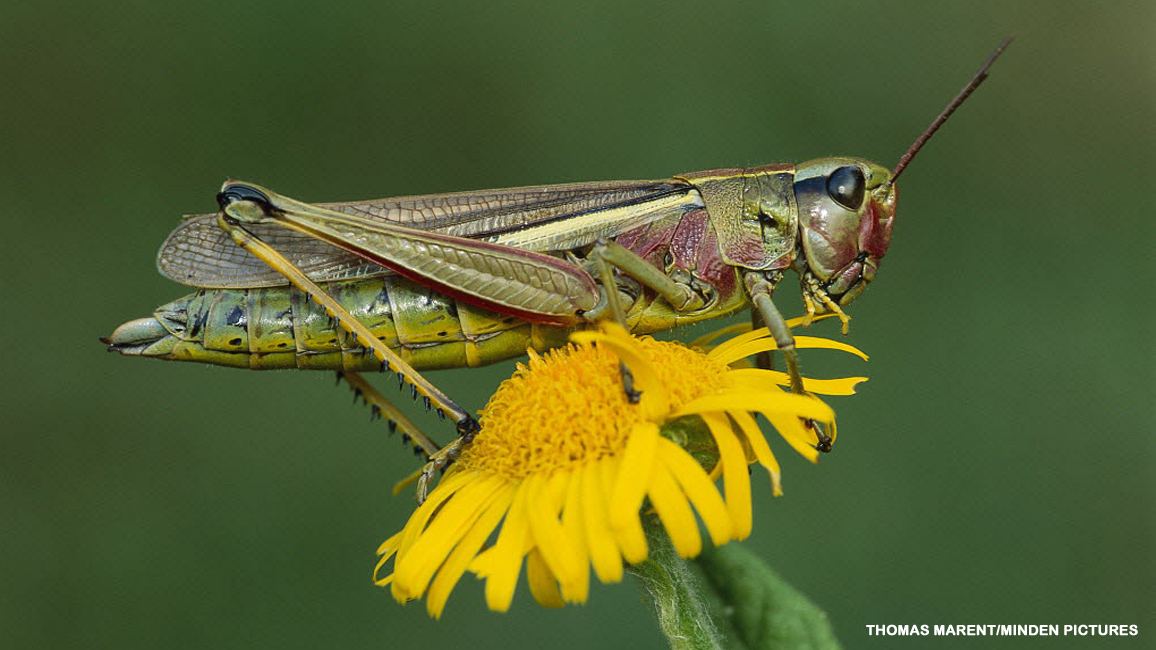
Grasshoppers
By Deborah Churchman and Ellen LambethSome insect names make no sense. A dragonfly, for example, isn’t a dragon OR a fly. But a grasshopper is usually just what it says it is. Many species of grasshoppers do live in grass. And most are great hoppers. Want to learn more? Hop aboard!

NOISEMAKERS
A few grasshoppers use sounds to attract mates. Some rub bumps on their hind legs against the edges of their wings. Others make a snap-crackle-pop sound with their wings.
SIDE EARS
A tympanum (TIM-puh-num) on each side of the body works as an eardrum to pick up sounds.
MAKING SENSE
Two antennae help a hopper feel and smell.
MIND THOSE SPINES!
Sharp spines on the rear legs can deliver a painful blow when a grasshopper kicks at anything that tries to grab it.
“EYE” SEE YOU
A grasshopper has two big compound eyes. Each is made up of hundreds of tiny lenses that work together to see shapes and motion. Three simple eyes sense only light.
MUSCLE POWER
Rows of strong muscles in the rear legs help hoppers hop—some as far as 20 times their body length! For extra power, most species are strong fliers, too.
CHOMP-CHOMP!
A hopper has several kinds of mouthparts, including jaws for nibbling leaves, stems, or flowers. Finger-like palps feel, hold, and move the food into the mouth.

HOPPER TRICKS
No one likes being caught by an enemy. So, it pays to either put up a good fight or avoid being seen in the first place.
A GOOD DISGUISE
Many grasshoppers come in shades of green or brown that blend in with their surroundings. Some are even leaf-shaped. So, how should a stone grasshopper look when it lives in a place such as this? Like a stone, of course! Can you find it?
STAND OUT
This Leichhardt’s grasshopper doesn’t hide from anything. It stands out like a beacon, which is exactly the point. The bright colors are a warning signal. If a bird, lizard, or other predator “bugs” it, the hopper will spit up a sticky, stinky juice. Whoa!
FATAL FOAM
A koppie foam grasshopper shows off bright colors as a warning: Mess with me, and you’ll be sorry! In case of capture, the grasshopper can squirt out toxic bubbles from glands behind its head. This foam tastes nasty enough to make a predator let go. If eaten, it may even be nasty enough to kill
BOO! SURPRISE!
When this African bush grasshopper hangs out in leaf y shrubs, it may go unnoticed. But get too close, and it will open and flutter its wings, showing off the brightly colored hind ones. If that’s not enough to scare off danger, it can also ooze out a juicy poison.

HOPPERS GALORE
There are more than 12000 known species of grasshoppers in the world—and more yet to be discovered. That adds up to LOTS of hoppers!
LAYING EGGS
After mating, some female hoppers lay eggs in plant parts, but most bury them in loose soil. In this cutaway view, a female has stuck her long abdomen into the ground and pushed out a clump of yellow eggs and some white foam. The eggs and foam dry together to form an egg pod.
LIFE STAGES
Inside each egg, a baby hopper starts to grow. Once the eggs hatch, the young—called nymphs (NIMFS)—crawl out. As you can see here, nymphs look like tiny adults. They’ll eat and grow, shedding their skin up to five or six times before they turn into adults.
SWIRLING SWARM
Sometimes there are too many grasshoppers in an area and not enough food to go around. For some species in certain parts of the world, that’s when chemicals in their bodies turn them into locusts—sort of like mini insect versions of the Incredible Hulk. Locusts gather by the millions in huge swarms and migrate across the land, eating ever y plant in sight. There may be so many that they darken the sk y and wipe out farmers’ crops.
GULP!
Grasshoppers make a fine meal for many creatures, including this lizard. Bats and birds, spiders and snakes, turtles and toads, even other insects—and people—gobble up grasshoppers. Good thing there are plenty to go around!
















